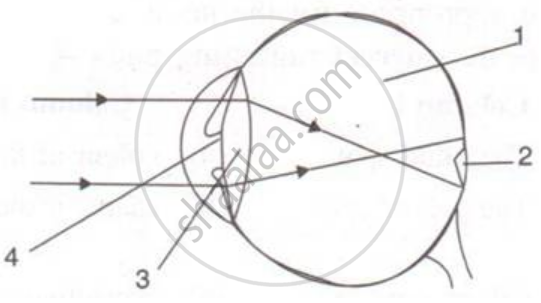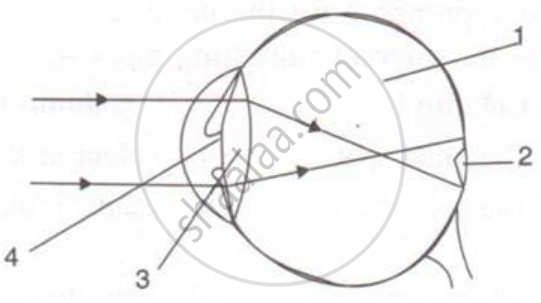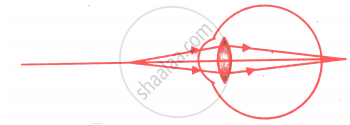Advertisements
Advertisements
प्रश्न
Given below is a diagram showing a defect of human eye. Study it and answer the following questions.

(i) Name the defect shown in the figure.
(ii) Give reason for this defect of eye in human being.
(iii) Name the type of lens used to correct the eye defect.
उत्तर
(i) The defect shown in the figure is hypermetropia or long-sightedness.
(ii) Two possible reasons are
a) Ciliary muscles have become weak, so the converging power of the eye lens decreases.
b) Because of shortening of the eye ball or flattening of the eye lens.
(iii) To correct the eye defect, a suitable convex lens is used.
APPEARS IN
संबंधित प्रश्न
In a Std. X class out of 40 students 10 students use spectacles, 2 students have positive power and 8 students have negative power of lenses in their spectacles.
Answer the following questions:
(1) What does the negative power indicate?
(2) What does the positive power indicate?
(3) Generally which type of spectacles do most of the students use?
(4) What defect of eyesight do most of the students suffer from?
(5) Give two possible reasons for the above defect.
List three common refractive defects of vision. Suggest the way of correcting these defects.
Name the defect of vision in a person:
whose near point is more than 25 on away.
What is the scientific name of
short-sightedness
What is the scientific name of
long-sightedness?
Where is the near point of a person suffering from hypermetropia (or long-sightedness)?
A man can read the number of a distant but clearly but he finds difficulty in reading a book.
What type of spectacle lens should he use to correct the defect?
Explain with the help of labelled ray diagram, the defect of vision called myopia and how it is corrected by a lens.
An eye has a far point of 2 m. What type of lens in spectacles would be needed to increase the far point to infinity? Also calculate the power of lens required. Is this eye long-sighted or short-sighted?
The defect of vision which cannot be corrected by using spectacles is:
(a) myopia
(b) presbyopia
(c) cataract
(d) hypermetropia
Though a woman can see the distant object clearly, she cannot see the nearby objects clearly. She is suffering from the defect of vision called:
(a) long-sight
(b) short-sight
(c) hind-sight
(d) mid-sight
The defect of vision in which the eye-lens of a person gets progressively cloudy resulting in blurred vision is called:
(a) myopia
(b) presbyopia
(c) colourblindness
(d) cataract
A person can read a book clearly only if he holds it at an arm's length from him. Name the defect of vision:
if the person is an old man
Name the following:
The photosensitive pigment present in the rods of the retina.
Name the following:
The eye defect caused due to shortening of the eye ball from front to back.
Explain the terms ‘adaptation’ and ‘accommodation’ with reference to the eye.
Enumerate the common defects of vision, their causes and the possible methods of correcting them.
State one role of ciliary muscles in the human eye.
What eye defect is hypermetropia? Describe with a ray diagram how this defect of vision can be corrected by using an appropriate lens.
Observer the following diagram and answer the questions.
a) Which eye defect is shown in this diagram?
b) What are the possible reasons for this eye defect?
c) How this defect is corrected, write it in brief?

Given below is a diagram depicting a defect of the human eye? Study the same and answer the question that follow:

Give two possible reasons for this defect of the eye in human beings.
Given below is a diagram depicting a defect of the human eye? Study the same and answer the question that follow :

Name the type of lens used to correct this eye defect.
Rewrite the following table so as to match second and third column with first column.
|
Column I
|
Column II
|
Column III
|
|
(i) Myopia
|
Old age problem
|
Bifocal lens
|
|
(ii) Presbyopia
|
Nearsightedness
|
Concave lens.
|
The near point of the eye of a person is 50 cm. Find the nature and power of the corrective lens required by the person to enable him to see clearly the objects placed at 25 cm from the eye?
Give Reason:
When you enter into a dark room from bright because of sunlight, you can not see things for a few seconds.
Give Technical Term:
The type of lens used to correct myopia is
The diagram given below represents the cross-section of the human eye:

(i) Name the parts labeled 1—12.
(ii) What is the function of the part marked ‘10’?
(iii) What would happen if part ‘5’ is damaged or cut?
Study the following diagram carefully and then answer the questions that follow. The diagram is depicting a defect of the human eye :

(i) Identify the defect shown in the diagram.
(ii) Give two possible reasons for the above defect.
Choose the Odd One Out:
Write scientific reason.
Nearsightedness, this defect can be corrected by using spectacles with concave lens.
Given below is a diagram showing a defect of vision. Name the defect of vision and draw an accurately labelled diagram to correct this defect.

Myopia and hypermetropia can be corrected by:
Assertion: Concave mirrors are used as reflectors in torches, vehicle head lights and in search lights.
Reason: When an object is placed beyond the center of curvature of a concave mirror, the image formed is real and inverted.
Myopia may arise due to ____________.
Match the following:
| Column - I | Column - II |
| 1. Retina | a. Path way of light |
| 2. Pupil | b. Far point comes closer |
| 3. Ciliary muscles | c. near point moves away |
| 4. Myopia | d. Screen of the eye |
| 5. Hypermetropia | e. Power of accommodation |
Name the following:
Two kinds of accomodations.
